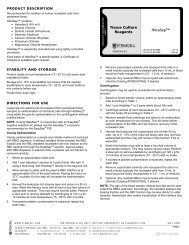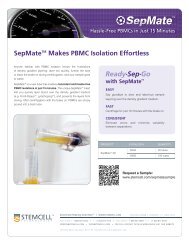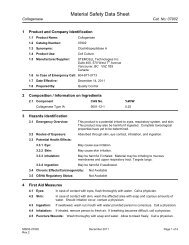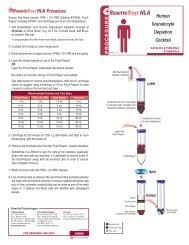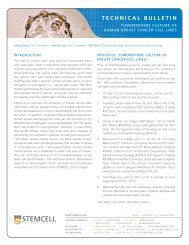AggreWell™: Reproducible, Uniform Embryoid Bodies - Stemcell ...
AggreWell™: Reproducible, Uniform Embryoid Bodies - Stemcell ...
AggreWell™: Reproducible, Uniform Embryoid Bodies - Stemcell ...
You also want an ePaper? Increase the reach of your titles
YUMPU automatically turns print PDFs into web optimized ePapers that Google loves.
<strong>Reproducible</strong> Production of<br />
<strong>Uniform</strong>ly-Sized <strong>Embryoid</strong> <strong>Bodies</strong><br />
Many pluripotent stem cell differentiation protocols begin with the<br />
formation of 3-dimensional aggregates of cells called embryoid<br />
bodies (EBs). Conventional EB formation methods 1,2 result in EBs<br />
that are heterogeneous in size and shape, leading to ineffi cient<br />
and uncontrolled differentiation 3 .<br />
Aggrewell TM plates solve this issue by aggregating pluripotent<br />
stem cells into EBs of defi ned size using microwells.<br />
<strong>Embryoid</strong> <strong>Bodies</strong> generated using<br />
AggreWell TM Plates are:<br />
• <strong>Uniform</strong> in size and shape<br />
• <strong>Reproducible</strong><br />
• Size-controlled<br />
AggreWell TM 400 and AggreWell TM 400Ex plates have microwells<br />
400 μm in diameter, and AggreWell TM 800 plates have microwells<br />
800 μm in diameter (Figure 1). EB formation is accomplished<br />
by adding a single cell suspension to the plate, centrifuging<br />
to distribute the cells evenly among the microwells, and then<br />
culturing for a minimum of 24 hours to allow aggregation of the<br />
cells within each microwell. The resulting EBs are highly uniform<br />
in size (Figure 2) and can be effi ciently differentiated into a<br />
variety of cell types (Figure 3) 4 . AggreWell TM plates bring an easy<br />
and standardized approach to the production of EBs, making<br />
differentiation experiments more reproducible. EBs and other cell<br />
aggregates 5 generated using AggreWell TM plates are consistent<br />
in size and shape, and uniform within and between experiments.<br />
THE CELL EXPERTS | WWW.STEMCELL.COM<br />
CATALOG #29150 | VERSION 1.1.1 | MAY 2011<br />
TOLL-FREE T. 1 800 667 0322 • T. +1 604 877 0713 • TOLL-FREE F. 1 800 567 2899 • F. +1 604 877 0704<br />
ORDERS@STEMCELL.COM • INFO@STEMCELL.COM • FOR FULL CONTACT DETAILS WORLDWIDE VISIT OUR WEBSITE<br />
FOR RESEARCH USE ONLY. NOT FOR THERAPEUTIC OR DIAGNOSTIC USE.<br />
AggreWell TM<br />
<strong>Reproducible</strong>, <strong>Uniform</strong> <strong>Embryoid</strong> <strong>Bodies</strong><br />
FIGURE 1. AggreWell TM contains microwells to make uniform cell aggregates.<br />
A<br />
A. AggreWell TM 400 and AggreWell TM 400Ex plates contain microwells 400 μm<br />
in diameter. Photo taken at 40x magnification.<br />
B. AggreWell TM 800 plates contain microwells 800 μm in diameter. Photo taken<br />
at 40x magnification.<br />
VIDEO<br />
AggreWell TM Introduction<br />
www.stemcell.com/AggreWellVideo<br />
B<br />
SCAN ME
FIGURE 2. Generate uniformly sized embryoid bodies using AggreWell TM .<br />
A. Human EBs formed using conventional methods are heterogeneous in size and<br />
shape resulting in inefficient differentiation.<br />
B. Human EBs formed using AggreWell plates over 24 hours are uniform in size<br />
and consistently spherical in shape. Shown are EBs generated with 2,000 cells<br />
using AggreWell400.<br />
C. Mouse EBs (not grown on feeders) formed using AggreWell400 plates for<br />
72 hours. Shown are EBs generated with 2,000 cells using AggreWell400.<br />
All photos taken at 100x magnification.<br />
2<br />
A B<br />
C<br />
AggreWell TM Products<br />
FIGURE 3. EBs generated using AggreWell TM 400 plates are able to differentiate<br />
into multiple cell types.<br />
A B<br />
Neural rosettes stained with PAX6<br />
(green) and SOX2 (red).<br />
C<br />
Hematopoietic cells were detected<br />
using CFC assays.<br />
Differentiated cells were generated by culturing AggreWell TM 400 - generated<br />
EBs in serum-containing suspension culture for A. 4 days (neural) or B. 14<br />
days (hematopoietic)*. Neural cells were assayed by plating onto gelatincoated<br />
dishes, and hematopoietic cells were assayed by plating in MethoCult TM<br />
(Catalog #04434). C. 100% Neural Induction can be achieved using AggreWell800<br />
plates and STEMdiff Neural Induction Medium (Catalog #05831). Neural<br />
aggregates of 10,000 cells each were formed in an AggreWell800 plate and<br />
STEMdiff Neural Induction Medium and cultured for 5 days with daily ¾ volume<br />
medium changes. Neural aggregates were then harvested and plated onto PLO/L<br />
coated plates. Attached neural aggregates are shown 2 days after attachment<br />
with prominent neural rosette structures visible (arrows). Magnification 20x.<br />
*Data reprinted from Ungrin et al., 2008. 5,8 See reference for full culture details.<br />
PRODUCT DESCRIPTION USE QUANTITY CATALOG#<br />
AggreWell TM 400 plate 8 wells, each with approximately 1,200 microwells<br />
AggreWell TM 800 plate<br />
AggreWell TM 400Ex plate<br />
AggreWell TM Medium<br />
AggreWell TM Rinsing Solution †<br />
37 μm Reversible Strainers,<br />
Small<br />
37 μm Reversible Strainers,<br />
Large<br />
For EBs composed of 50 to<br />
3000 cells<br />
8 wells, each with approximately 300 microwells For EBs composed of 3,000 to<br />
20,000 cells<br />
6 wells, each with approximately 4,700<br />
microwells<br />
For EBs composed of 50 to<br />
3000 cells<br />
Defined, serum-free medium for generation and culture of EBs using AggreWell TM<br />
plates<br />
Rinsing solution for AggreWellTM plates to reduce surface tension.<br />
Required for use with AggreWell TM 400Ex plates.<br />
37 μm nylon mesh filter, fits standard 14 mL round bottom tubes and 15 mL<br />
conical tubes<br />
1/pack 27845<br />
5/pack 27945<br />
1/pack 27865<br />
5/pack 27965<br />
1/pack 27840<br />
5/pack 27940<br />
100 mL 05893<br />
100 mL 07010<br />
20/box 27215<br />
37 μm nylon mesh filter, fits standard 50 mL conical tubes 12/box 27250<br />
† Required only if using AggreWell TM 400Ex (Catalog #27840/27940). It is not required but can be used with AggreWell TM 400 (Catalog #27845/27945) or AggreWell TM 800 (Catalog #27865/27965).<br />
NEW!<br />
NEW!<br />
NEW!
Easily Control the Size of <strong>Embryoid</strong> <strong>Bodies</strong><br />
AggreWell TM<br />
<strong>Reproducible</strong>, <strong>Uniform</strong> <strong>Embryoid</strong> <strong>Bodies</strong><br />
It has been shown that human as well as mouse EB size directly affects subsequent differentiation trajectories 3,4,6-10 . Since the number of<br />
microwells in each well of the AggreWell TM plate is known, it is easy to control the size of the resulting EBs simply by adjusting the number of<br />
cells added (Figure 4). Table 1 gives examples of the number of single cells required per well of an AggreWell TM 400, AggreWell TM 400Ex and<br />
AggreWell TM 800 plate to generate EBs of varying sizes.<br />
Table 1: Number of PSCs Required to Generate Various Sized EBs<br />
Using Aggrewell TM 400, Aggrewell TM 400Ex or Aggrewell TM 800 Plates<br />
DESIRED NUMBER OF<br />
CELLS PER EB<br />
FIGURE 4. The size of EBs can easily be adjusted using AggreWell TM plates. Here, EBs are formed by seeding the wells of an AggreWell TM 400 plate with varying<br />
concentrations of single hESCs so that approximately 500 or 2,000 cells seed each microwell.<br />
500 H9 hESCs seed each microwell.<br />
2000 H9 hESCs seed each microwell.<br />
AGGREWELL400<br />
(Each Well Contains Approximately<br />
1,200 Microwells)<br />
REQUIRED NUMBER OF CELLS PER WELL<br />
AGGREWELL400Ex<br />
(Each Well Contains Approximately<br />
4,700 Microwells)<br />
50 6.0 x 10 4 cells 2.3 x 10 5 cells -<br />
100 1.2 x 10 5 cells 4.7 x 10 5 cells -<br />
200 2.4 x 10 5 cells 9.4 x 10 5 cells -<br />
500 6.0 x 10 5 cells 2.3 x 10 6 cells -<br />
1,000 1.2 x 10 6 cells 4.7 x 10 6 cells -<br />
2,000 2.4 x 10 6 cells 9.4 x 10 6 cells -<br />
3,000 3.6 x 10 6 cells 1.4 x 10 7 cells 9.0 x 10 5 cells<br />
4,000 - - 1.2 x 10 6 cells<br />
5,000 - - 1.5 x 10 6 cells<br />
10,000 - - 3.0 x 10 6 cells<br />
15,000 - - 4.5 x 10 6 cells<br />
20,000 - - 6.0 x 10 6 cells<br />
Count<br />
500 cells/EB<br />
2000 cells/EB scraped EBs<br />
Area (micron 2<br />
) x 10 3<br />
AGGREWELL800<br />
(Each Well Contains Approximately<br />
300 Microwells)<br />
H9 hESCs were centrifuged into AggreWell TM 400 plates and cultured for 24 hours<br />
prior to EB harvest. EB size is tightly controlled with AggreWell TM (light and dark grey),<br />
unlike with scraping protocols (brown) that give a wider distribution.<br />
3
Optimized AggreWell TM Products<br />
Optimize the generation and isolation of EBs with the use of either<br />
AggreWell TM Medium or STEMdiff TM APEL TM Medium and the 37 μm<br />
Reversible Cell Strainer. Both AggreWell TM Medium and STEMdiff TM<br />
APEL TM Medium support EB formation without serum or added<br />
growth factors, and are compatible with mTeSR TM 1- and TeSR TM 2grown<br />
cells. After formation in AggreWell TM , EBs of greater than<br />
50 cells can be collected in and easily recovered from the 37 μm<br />
Reversible Cell Strainer, allowing for easy isolation of EBs from any<br />
residual non-incorporated cells.<br />
Rinsing with AggreWell TM Rinsing Solution lowers the surface<br />
tension of the AggreWell TM plate, thereby making it easier for air<br />
bubbles to be released from the microwells when medium is<br />
added and the plate is subsequently centrifuged. The lowered<br />
surface tension also makes it easier to remove embryoid<br />
bodies (EBs) from the microwells after EB formation. Although<br />
the use of AggreWell TM Rinsing Solution is required only when<br />
using AggreWell TM 400Ex plates, it can also be used to rinse<br />
AggreWell TM 400 or AggreWell TM 800 plates.<br />
References<br />
1. Itskovitz-Eldor J, et al. Differentiation of human embryonic stem<br />
cells into embryoid bodies compromising the three embryonic<br />
germ layers. Mol Med 6:88-95, 2000<br />
2. Kurosawa H. Methods for inducing embryoid body formation:<br />
in vitro differentiation system of embryonic stem cells. J Biosci<br />
Bioeng 103:389-398, 2007<br />
3. Bauwens C L et al. Control of human embryonic stem cell colony<br />
and aggregate size heterogeneity infl uences differentiation<br />
trajectories. Stem Cells 26:2300-2310, 2008<br />
4. Ungrin MD, et al. <strong>Reproducible</strong>, ultra-high-throughput formation<br />
of multicellular organization from single cell suspension-derived<br />
human embryonic stem cell aggregates. PLoS One 3(2):e1565,<br />
2008<br />
5. Markway BD et al. Enhanced chondrogenic differentiation of human<br />
bone marrow-derived. Mesenchymal stem cells in low oxygen<br />
environment micropellet cultures. Cell Transplantation. 19:29–42,<br />
2010<br />
Related Products<br />
AggreWell TM<br />
<strong>Reproducible</strong>, <strong>Uniform</strong> <strong>Embryoid</strong> <strong>Bodies</strong><br />
PRODUCT CATALOG #<br />
STEMdiff TM APEL TM Medium 05210<br />
STEMdiff TM Neural Induction Medium 05831<br />
STEMdiff TM Neural Rosette Selection Reagent 05832<br />
Y-27632 07171 / 07172<br />
EasySep TM SSEA-4 Positive Selection Kit 18165 / 18145<br />
EasySep TM hESC-Derived CD34 Positive<br />
Selection Kit<br />
STEMcircles TM -LGNSO 05820<br />
18167/ 18147<br />
Oct 3/4 Antibody, Clone 40 01550 / 01551<br />
SSEA-1 Antibody, Clone MC-480 01552<br />
SSEA-3 Antibody, Clone MC-631 01553<br />
SSEA-4 Antibody, Clone 813-70 01554<br />
TRA-1-60 Antibody, Clone TRA-1-60 01555<br />
TRA-1-81 Antibody, Clone TRA-1-81 01556<br />
TRA-2-49 Antibody, Clone TRA-2-49/6E 01557<br />
TRA-2-54 Antibody, Clone TRA-2-54/2J 01558<br />
mTeSR TM1 Defined Maintenance Medium<br />
05850 / 05870<br />
05875 / 05857<br />
mFreSRTM Defined Cryopreservation Medium 05855 / 05854<br />
CryoStorTM CS10 Animal Protein-Free<br />
Cryopreservation Medium<br />
07930<br />
Dispase (1 mg/mL) 07923<br />
6. Bratt-Leal AM, et al. Engineering the embryoid body<br />
microenvironment to direct embryonic stem cell differentiation.<br />
Biotechnology Progress 25:43-51, 2009<br />
7. Hwang Y-S et al. Microwell-mediated control of embryoid body<br />
size regulates embryonic stem cell fate via differential expression<br />
of WNT5a and WNT11. Proceedings of the National Academy of<br />
Sciences 106:16978-16983, 2009<br />
8. Messana JM, et al. Size of the embryoid body infl uences<br />
chondrogenesis of mouse embryonic stem cells. Journal of Tissue<br />
Engineering and Regenerative Medicine 2:499-506, 2008<br />
9. Mohr JC, et al. The microwell control of embryoid body size in<br />
order to regulate cardiac differentiation of human embryonic stem<br />
cells. Biomaterials 31:1885-1893, 2010<br />
10. Ng ES, et al. Forced aggregation of defi ned numbers of human<br />
embryonic stem cells into embryoid bodies fosters robust,<br />
reproducible hematopoietic differentiation. Blood 106:1601-1603,<br />
2005<br />
Copyright © 2011 by STEMCELL Technologies Inc. All rights reserved including graphics and images. STEMCELL Technologies and Design, STEMCELL shield, CELL EXPERTS (THE), STEMcircles,<br />
STEMdiff, AggreWell, MethoCult and EasySep are trademarks of STEMCELL Technologies Inc. All other trademarks are the property of their respective holders.<br />
NEW!



